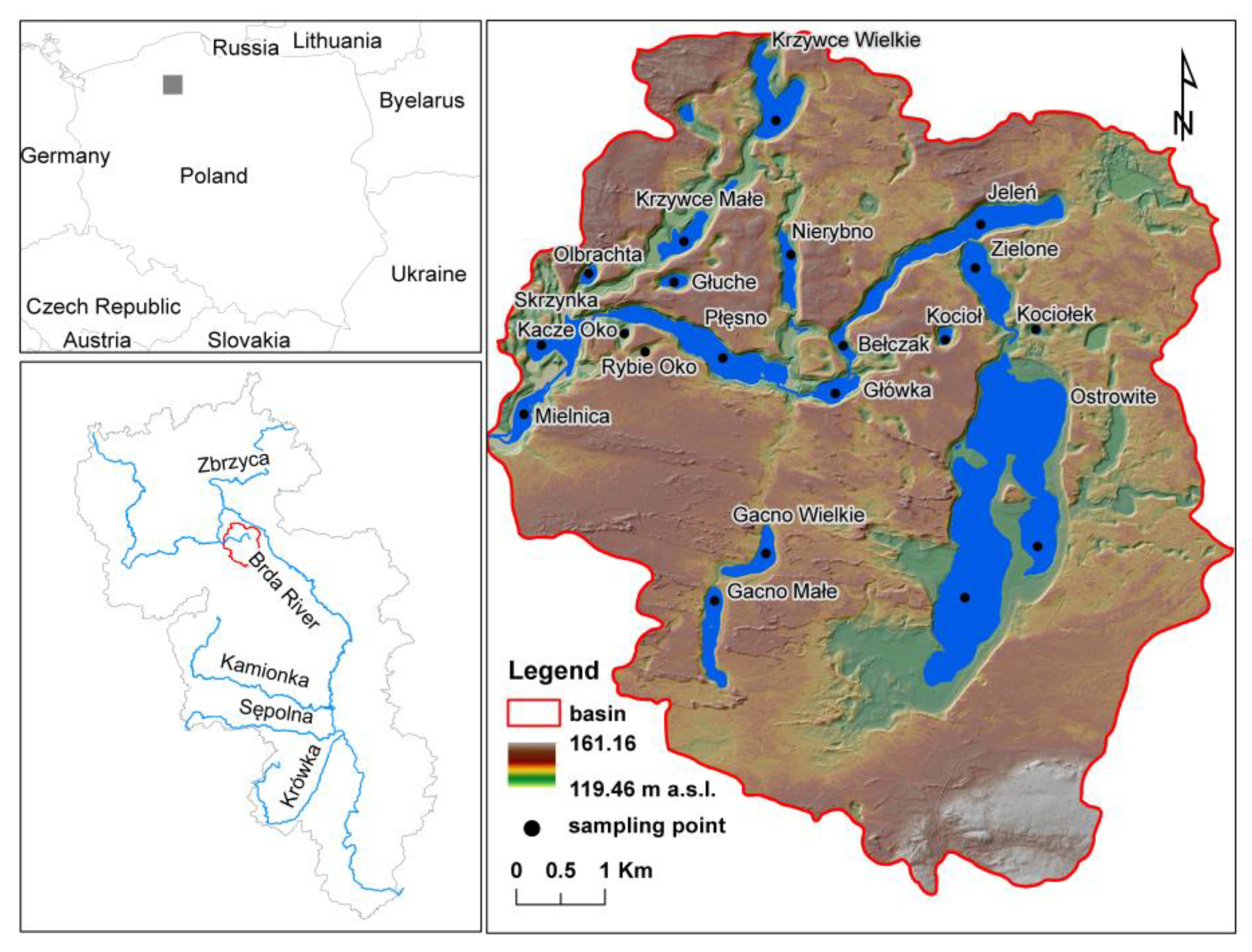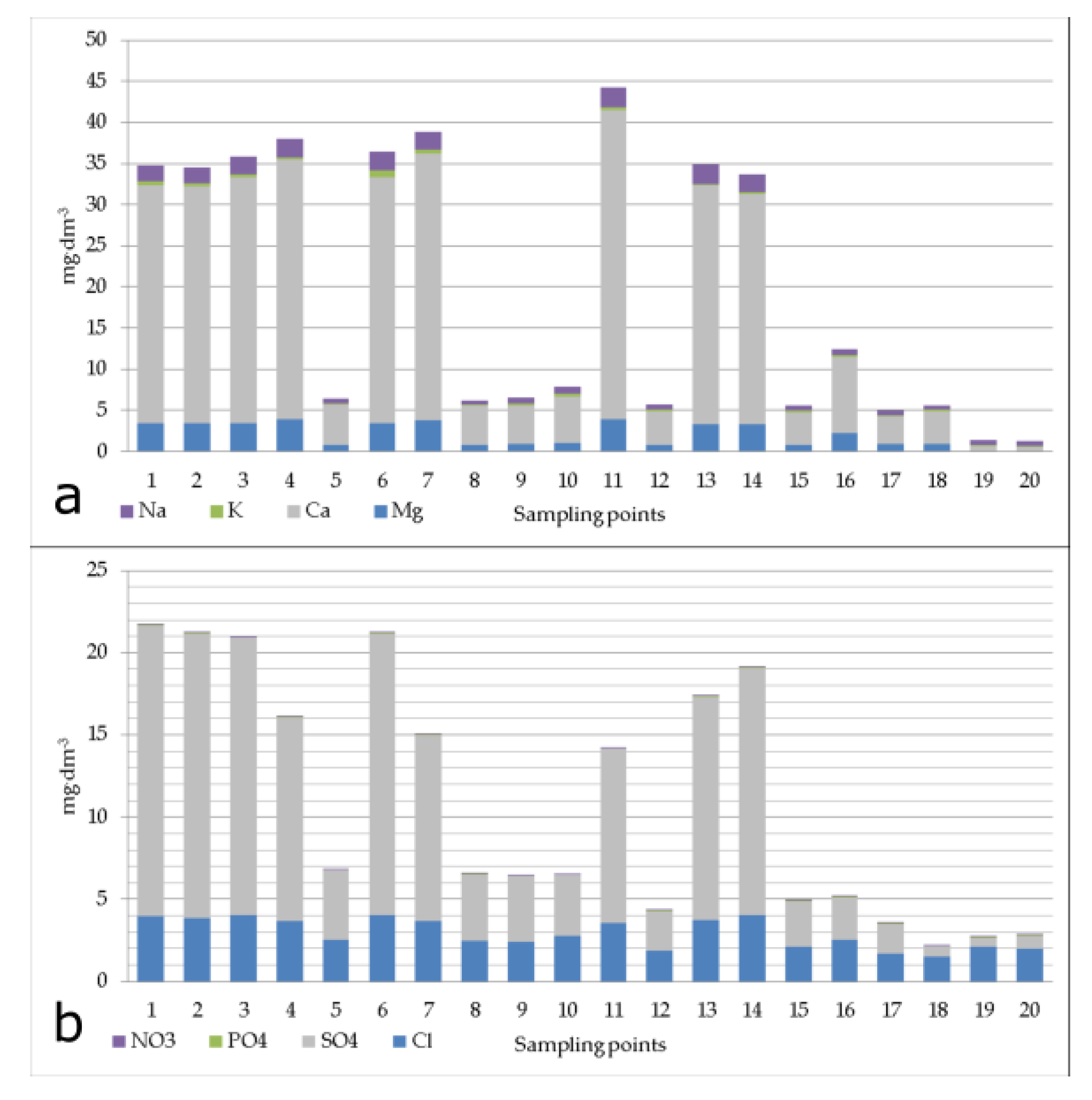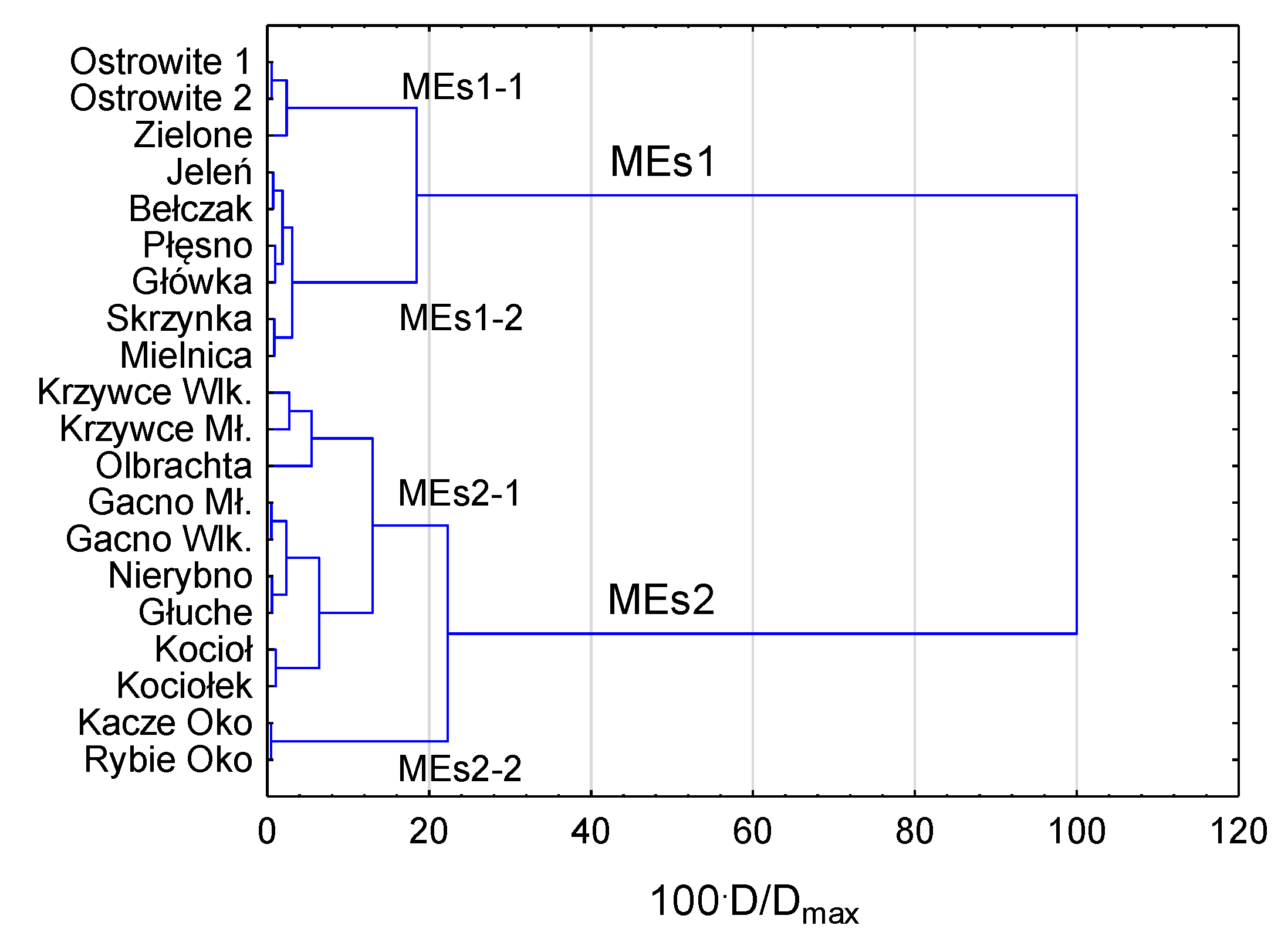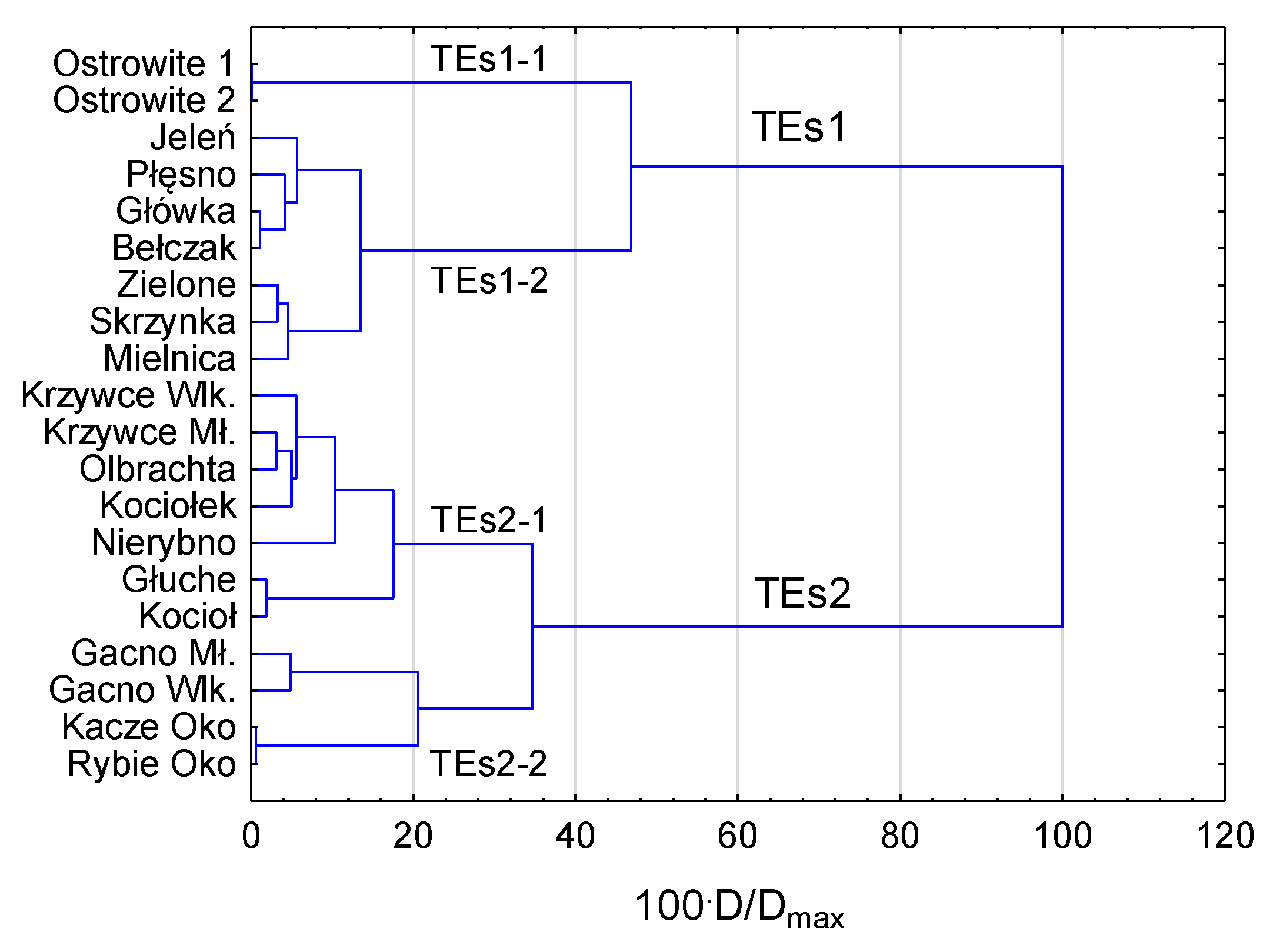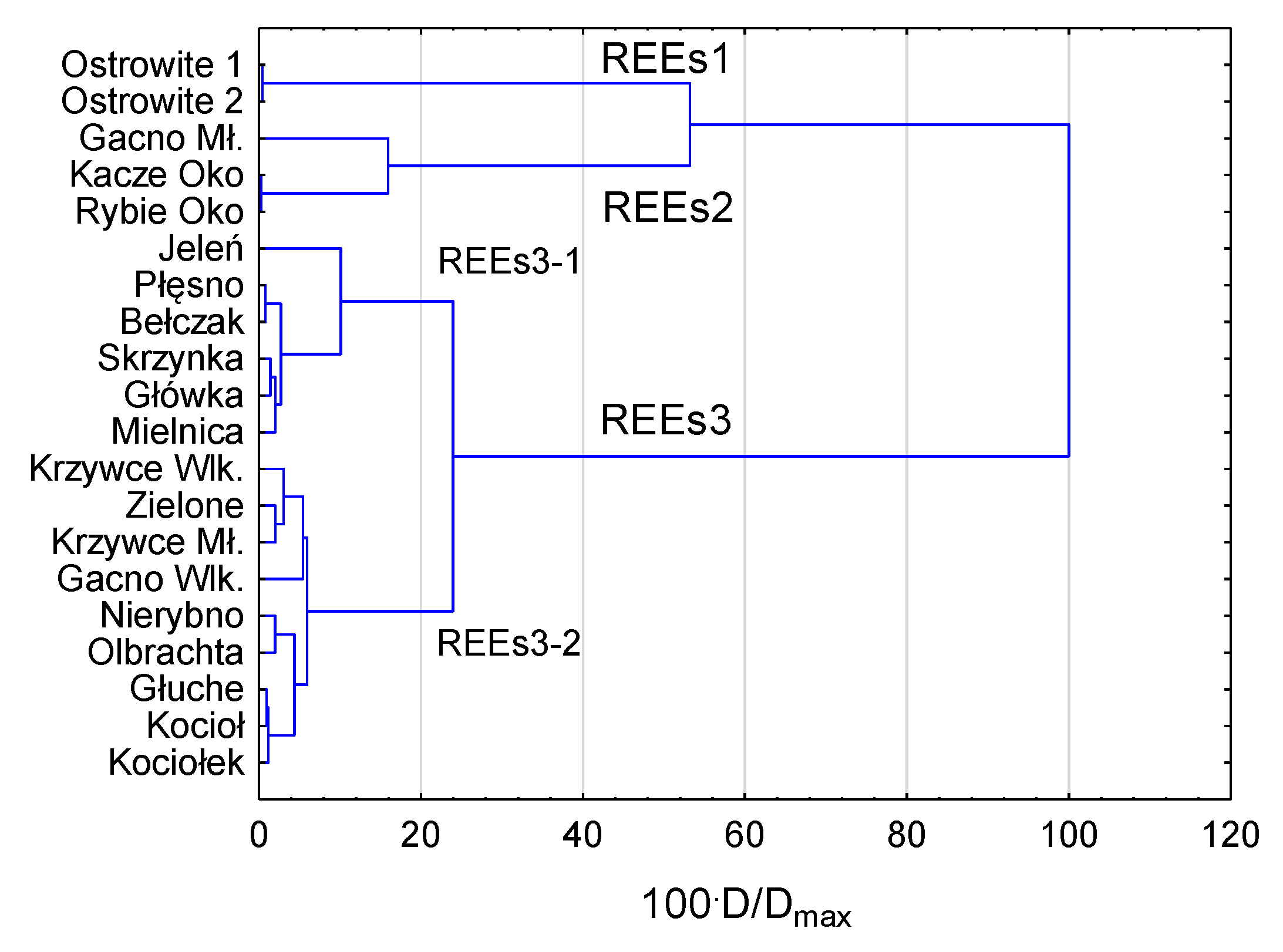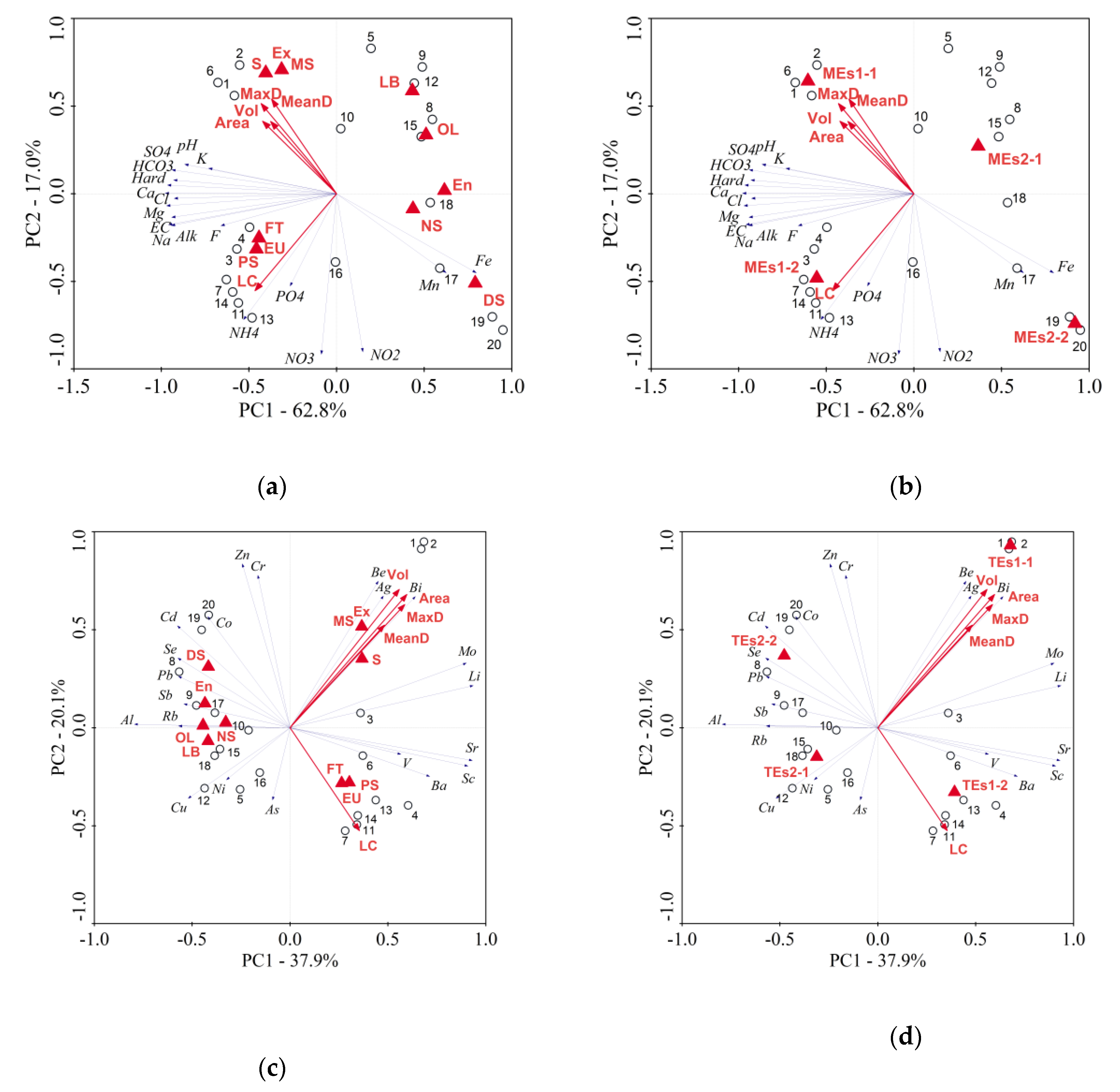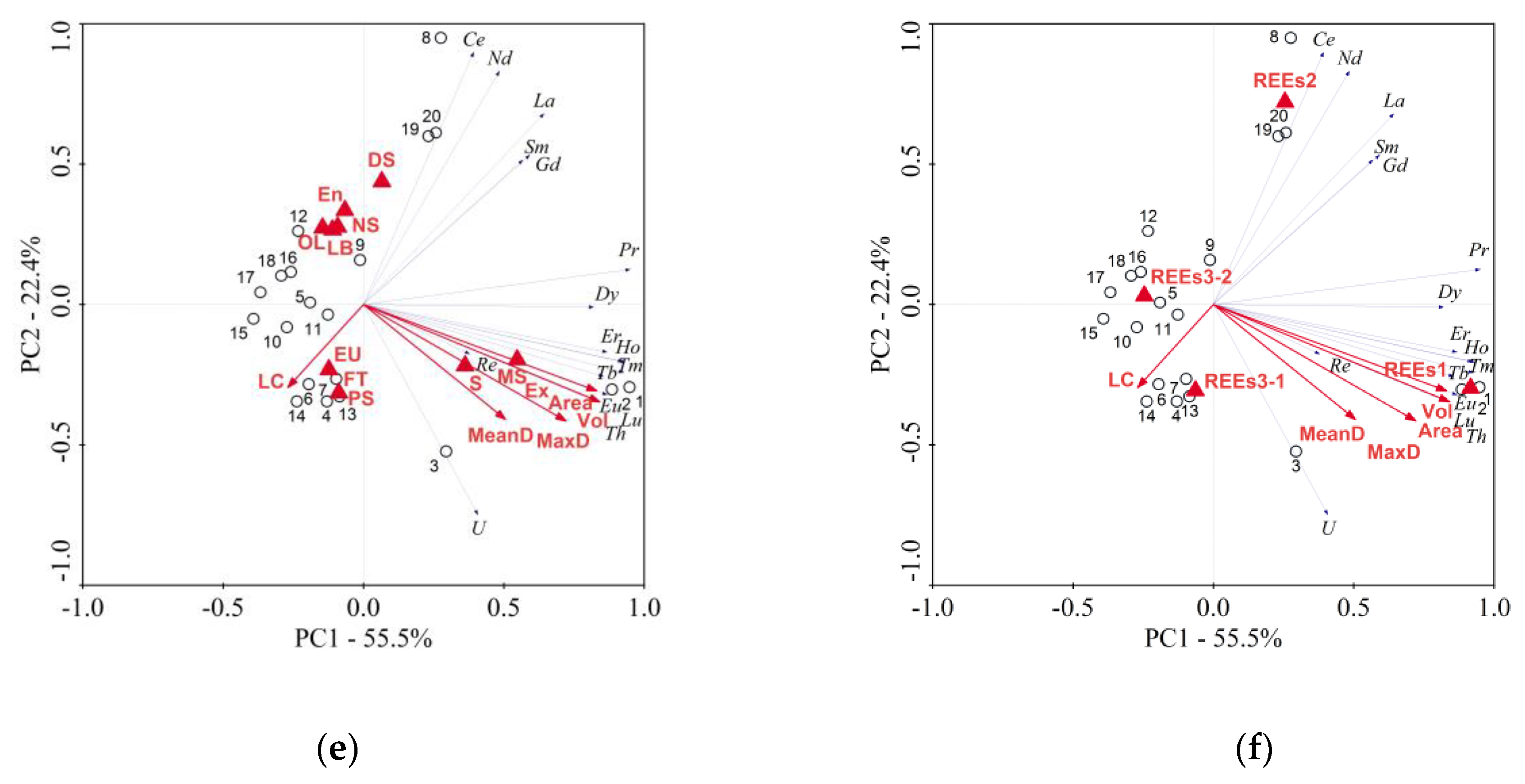3.1. Lakes Water Chemistry
The results revealed that in most of the sampling sites, the water was slightly alkaline (from 8.00 to 9.22). The above values usually indicate the presence of carbonates of calcium and magnesium in water [
55,
56]. The high pH of the water may result in the reduction of TEs and REEs [
57]. The acid reaction of waters was found in eight reservoirs (from 4.33 to 6.97), with the lowest pH being found in dystrophic reservoirs. The electrical conductivity (EC) of the water samples ranged from 10.7 to 269 μS/cm. Low concentrations of basic anions and cations were found in the lake waters, and the ion abundances were typically Ca
2+ > Mg
2+ > Na
+ > K
+ > NH
4+ (
Figure 2a) and SO
42− > Cl
− > PO
43− > NO
3− >NO
2− (
Figure 2b).
The results of the chemical analyses of water samples for macro elements (MEs), trace elements (TEs) and rare earth elements (REEs) are presented in
Table A1,
Table A2 and
Table A3. Maximum concentrations of MEs, TEs and REEs obtained during the study were compared with values from the European Geochemical Atlas recorded in surface waters of Europe, covering 26 countries, including Poland [
58]. ME, TE and REE concentrations presented in the Geochemical Atlas of Europe have right-skewed distribution, i.e., median values are lower than the mean value. The results indicate that the maximum concentrations of F
−, Cl
−, Ca
2+, Mg
2+, Na
+, K
+, Sr, Cr, Ni, Ba, V, Co, Dy and U recorded in the BTNP lakes were higher than the minimum value and lower than the median value from the Geochemical Atlas of Europe. Fe, HCO
3−, SO
42−, Li, Se, Rb and most of the REEs (La, Ce, Pr, Nd, Sm, Eu, Gd, Er) were higher than the median and lower than the mean value recorded in surface waters in Europe. In other cases, the maximum concentrations were higher than the mean value and only in the case of Bi exceeded the maximum value given by Salminen et al. [
58]. In areas without a direct impact of anthropogenic factors, the content of MEs, TEs and REEs depends on the geological structure and the weathering process. Wang et al. [
59] suggested that a large amount of TEs may originate from atmospheric deposition and weathering of background soils. Similarly, for REEs, their surface water content may also be affected by dry and wet deposition of REEs from the atmosphere (dust, particles, rain, snow). The content of REE in the atmosphere is dependent on anthropogenic factors, especially near cities [
60]. The analysis showed that the concentrations of individual elements in the lake waters were characterized by unequal variability. Average variability of parameters in ME and TE groups was at a similar level, whereas parameters in the REE group were characterized by the highest variability. Very high variability in the ME group was observed for pH and alkalinity, HCO
3−, hardness, electrolytic conductivity and concentrations of Ca
2+, Fe and Mn, in the TE group Co, Mo, Sr, Al and Bi and among the REEs, La, Pr, Sm, Tb, Dy, Ho and Tm. On the other hand, the lowest variation was observed for NO
3−, Cl
−, F
−, Se and Rb concentrations. The variability of other parameters was at an average or high level. Taking into account that the analyzed lakes are located within a relatively small area of about 46.13 km
2, none of the recorded concentrations have very low variability. The variability of MEs, TEs and REEs results from the diverse geological structure. As a result of the weathering process, REEs are easily activated and transferred from the rock environment to water. The content of REEs in surface waters (rivers and streams) varies considerably. Studies indicate that the content of REEs in river waters is mainly controlled by two factors, namely organic matter content and water pH [
60].
3.2. Statistical Analysis
Cluster analysis was carried out in order to show similarities and differences in the chemical composition of waters in lakes. CA analysis was performed separately for MEs, TEs and REEs. On the basis of the ME analysis, the lakes were divided into two main groups, MEs1 and MEs2, within which two subgroups were separated (
Figure 3).
The MEs1 group includes the Ostrowite and Zielone lakes and Jeleń, Bełczak, Płęsno, Główka, Skrzynka and Mielnica. The MEs1-1 subgroup contains the Ostrowite and Zielone lakes, which are located in the near vicinity. According to trophic typology, these are mesotrophic and eutrophic reservoirs, respectively, where stratification occurs. Moreover, there is a hydrological connection between the lakes; the reservoirs are connected by the Struga Siedmiu Jezior stream. In the MEs1-2 subgroup, there are eutrophic and flow lakes, mainly partially stratified. These reservoirs are connected by the Struga Siedmiu Jezior stream, which continuously provides water. In the second group of MEs2 the MEs content was more varied, which results from the lack of direct hydrological connection or periodic hydrological connection (Krzywce Wielkie, Krzywce Małe, Olbrachta). The MEs2-1 subgroup includes nine lakes, mainly oligotrophic, non-stratified and endorheic reservoirs. In the MEs2-1 subgroup, high similarity of macroelement concentrations was observed in the lakes of Krzywce Wielkie, Krzywce Małe and Olbrachta, which are located in one tunnel valley and are additionally connected by an artificial channel periodically supplying water. The two smallest lakes, Kacze Oko and Rybie Oko, are classified in the MEs2-2 subgroup; they are dystrophic, non-stratified and endorheic lakes. Analysis of concentrations of individual macroelements of separated waters showed that MEs1 had higher pH, EC, Alkalinity, Hardness, HCO
3− and mean concentrations of Cl
−, SO
42−, K
+, Na
+, Mg
2+ and Ca
2+. In the MEs2 group very high concentrations of Mn and Fe were recorded. Concentrations of PO
43−, NO
3−, NO
2− and NH
4+ were at very different levels in individual groups. Higher concentrations were generally found in MEs1-2 and MEs2-2 subgroups. Cluster analysis carried out on the basis of TEs allowed the lakes to be divided into TEs1 and TEs2 groups as well. The TEs2 group was generally characterized by higher concentrations of Al, Ni, Cu, Se, Rb, Sb and Pb than the TEs1 group. Higher concentrations of Li, Sc, V, Sr, Mo, Ba and Bi were recorded in the TEs1 group. Within the TEs1 group two subgroups were distinguished. The TEs1-1 subgroup includes sample points located in Ostrowite Lake. Seven lakes were included in the second subgroup of TEs1-2 (
Figure 4).
The Struga Siedmiu Jezior stream flows through the lakes of the TEs1-2 group. The lakes included in this group are mainly eutrophic-partially stratified. The TEs2 group includes 11 lakes, seven of which belong to the TEs2-1 subgroup and four to the TEs2-2 subgroup. Among the lakes included in the second group are the endorheic and flow-through lakes: lakes Krzywce Wielkie, Krzywce Małe and Olbrachta. The TEs2 group consisted mainly of non-stratified reservoirs. The TEs2 group was characterized by greater diversity of trace elements content than the TEs1 group. This is mainly due to the lack of hydraulic connection, and the content of trace elements in waters is determined mainly by the geological structure and supplied with groundwater. In flow-through lakes, trace elements can be transported by suspended sediments. The CA analysis carried out in relation to REEs allowed the lakes to be divided into three groups: REEs1, REEs2 and REEs3 (
Figure 5).
The REEs1 group included Ostrowite Lake and the REEs2 group included the three lakes Gacno Małe, Kacze Oko and Rybie Oko, which are located on the left bank of the Struga Siedmiu Jezior stream. The lakes are endorheic reservoirs in which there is no thermal stratification of waters. In terms of trophic state, Kacze Oko and Rybie Oko are dystrophic lakes and Gacno Małe is an oligotrophic lake. The third group consisted of 15 lakes divided into two subgroups: REEs3-1 and REEs3-2. Less diverse concentrations of REEs were observed for the REEs3-2 group, which included nine lakes, mainly endorheic lakes or lakes located on periodic streams. Zielone Lake, located just below Ostrowite Lake, is an exception in this group. The trophic state of lakes and thermal conditions vary significantly in this group. In the REEs3-1 group there are only flow-through lakes connected by the Struga Siedmiu Jezior stream. According to trophic typology, these lakes are classified as eutrophic lakes, whereas in terms of thermal conditions they are mainly stratified lakes. Analysis of REE concentrations in separated groups showed that the highest concentrations were found in Ostrowite Lake. In the remaining groups the highest mean concentrations were found in lakes included in the REEs3-2 group, then REEs2, and the lowest concentrations were found in lakes included in the REEs3-1 group.
Summarizing the cluster analysis according to MEs, TEs and REEs, lakes can be divided into six groups: I Lake Ostrowite, II Lake Zielone, III lakes Jeleń, Bełczak, Główka, Płęsno, Skrzynka and Mielnica, IV lakes Krzywce Wielkie, Krzywce Małe, Nierybno, Głuche, Olbrachta, Kocioł and Kołek, V lakes Kacze Oko and Rybie Oko and VI lakes Gacno Wielkie and Gacno Małe. The first group includes Lake Ostrowite, the functioning of which is independent of other lakes. The deep lake bowl is mainly supplied with groundwater. Group II includes Lake Zielone, which is a buffer between Lake Ostrowite and other lakes that are part of the river-and-lakes system of the Struga Siedmiu Jezior. The lake has a small surface area and an average depth of approximately 9.0 m, and the waters are fully stratified. The lakes Jeleń, Bełczak, Główka, Płęsno, Skrzynka and Mielnica are lakes where there is no full stratification and their average depth ranges from 0.7 to 4.7 m (Group III). These lakes are also exposed to a high supply of matter from the catchment; the lake coefficient varies from 47.1 to 544.2. The lakes of group V, depending on the type of analyzed water quality parameters, changed their membership in particular groups.
The subject of the next analysis was to assess the variability of concentrations of analyzed water quality parameters divided into groups determined by the CA method. The analysis for macro elements was performed for the four subgroups MEs1-1 (N = 3), MEs1-2 (N = 6), MEs2-1 (N = 9), MEs2-2 (N = 2), trace elements for the four groups TEs1-1 (N = 2), TEs1-2 (N = 7), TEs2-1 (N = 7), TEs2-2 (N = 4) and for rare earth elements for the four groups REEs1 (N = 2), REEs2 (N = 3), REEs3-1 (N = 6) and REEs3-2 (N = 9). For each group of lakes, the values of characteristic concentrations—minimum, maximum, mean and standard deviation—were calculated and are presented in
Table 3,
Table 4 and
Table 5.
Then, in order to analyze the differences in the concentrations of parameters determined in the groups of lakes, the non-parametric tests of variance Kruskal–Wallis and Dunn’s tests were conducted as post hoc procedures. The results of the analysis of differences are presented in
Table 6.
The results show that in the groups determined with the CA method there were statistically significant differences for all MEs. Among TEs no significant differences were observed for Ni, Cu, V, As, Cd and Ag, and among REEs for Lu and Th.
In the next stage of statistical analysis, the DCA analysis was carried out separately for MEs, TEs and REEs. This analysis showed that gradient length of the first axis for MEs, TEs and REEs was 0.85, 0.65 and 0.63, respectively. These values were lower than 3.0, which indicates that the parameters were in linear distribution. For this type of data, further analysis was carried out using the PCA method.
The results of the linear ordination method PCA for lakes (represented by circle), concentrations of MEs, TEs and REEs (represented by thin dark blue arrows), quantitative environmental variables such as area, volume, mean and maximum depth (represented by thick red arrows) and nominal variables representing lake nutrient status, thermic and hydrological condition and belonging to a group designated by CA methods (represented by red triangles) are presented in
Figure 6. The projection of the sample points (lakes) perpendicular to arrows enables the lake to be ordered according to concentration of selected parameters in the water. The lakes projecting further from zero in the direction of the arrow are predicted to have above-average concentration, while the lakes projecting in the opposite direction are predicted to have below-average values. Analogously, an analysis of the content of individual elements in the lake waters characterized by a specific trophic, thermal and hydrological state and in the groups separated by the CA method was carried out. The presented graphs also allow for evaluation of the correlation between individual elements; when the arrows point in the same direction the parameters are positively correlated with each other, when they point in the opposite direction the correlation is negative and when they intersect at a right angle there is no correlation.
The PCA analysis carried out for MEs, based on the Kaiser criterion, allowed two significant principal components whose eigenvalues were higher than 1 to be distinguished. The components PC1 and PC2 explain respectively 62.8% and 17.0% of the internal data structure. The first main component of PC1 was strongly correlated with the values of pH, EC, Hardness, Alkalinity and HCO
3− as well as concentrations of Cl
−, SO
42−, Ca
2+, Mg
2+, Na
+. A moderate negative correlation was recorded for NH
4+, F and K
+ concentrations. The concentrations of Fe and Mn were positively correlated with PC1 at strong and moderate levels, respectively. There was a negative correlation with the second main component of PC2 at a strong level for NO
2− and NO
3− and at a moderate level for NH
4+ and PO
43− (
Figure 6a,b).
Projection of environmental values against the background of macro element concentrations made it possible to determine the relationships between lakes. Eutrophic and dystrophic lakes are characterized by a higher content of nitrogen and phosphorus compounds compared to oligotrophic and mesotrophic lakes. Statistical analysis also showed that lakes with high inflow from the catchment were characterized by the highest values of NH
4+ and PO
43−. Moreover, lobelia lakes are the most similar in terms of ME content to oligotrophic lakes. In this type of lake, the lowest values of all examined MEs were found. The lakes with the lowest depths, surface area and at the same time low capacity—Kacze Oko and Rybie Oko (19 and 20)—were characterized by the highest values of Mn and Fe. The lowest values of Mn and Fe were recorded in Ostrowite (1 and 2) and Zielone (6) lakes (
Figure 6a). The obtained results confirmed the earlier classification into groups by the CA method, each of the separated groups being located in a separate part of the coordinate system. The lakes Ostrowite (1 and 2), Zielone (6) (MEs1-1) and Jeleń (3), Bełczak (14), Płęsno (4), Główka (13), Skrzynka (7) and Mielnica (11) (MEs1-2) were characterized by relatively low variability, which is indicated by their small dispersion (
Figure 6b). The lakes Krzywce Wielkie (5), Krzywce Małe (10), Olbrachta (16), Gacno Małe (8), Gacno Wielkie (9), Nierybno (12), Głuche (15), Kocioł (17) and Kociołek (18) (MEs2-1) were the most diversified. High similarity of water composition in terms of ME content was found in Kacze Oko (19) and Rybie Oko (20) lakes.
The PCA analysis carried out on the basis of TEs made it possible to distinguish three main components, PC1, PC2 and PC3, whose eigenvalues were greater than 1. The extracted main components explain, respectively, 37.9%, 20.1% and 11.1% of the internal data structure. The concentrations of Sr, Li, Mo and Sc were strongly positively correlated with PC1, while the values of Be, Zn and Cr were strongly correlated with PC2. The dispersion of the analyzed TE shows their high variability in the lakes water. A similarity was observed between the TEs content in the waters of lakes classified as dystrophic and oligotrophic, which are at the same time non-stratified and endorheic lakes (
Figure 6c). A strong positive correlation was observed between the surface area, volume and depth of the lakes and the content of Ag, Bi and Be. In eutrophic, partially stratified and flow-through lakes increased values of Ba, Sc, Sr and V were noted. The results of PCA analysis confirmed the results obtained by CA; the TEs1 group was more diverse than the TEs2 group, which is confirmed by the dispersion of points representing particular subgroups (
Figure 6d). PCA results for REEs allowed two main components to be selected, PC1 and PC2, which explain, respectively, 55.5% and 22.4% of the internal data structure. Pr, Eu, Tb, Dy, Ho, Er, Tm, Lu and Th were strongly correlated with PC1. Ce and Nd values were strongly correlated with PC2 and negatively with U. Generally, the highest concentrations of REEs were found in Ostrowite Lake, except for La, Ce, Nd, Gd and Sm, of which the highest concentrations were found in Gacno Małe Lake (8), Rybie Oko (20) and Kacze Oko (19). The lowest REE contents were found in oligotrophic and eutrophic lakes (
Figure 6e). Moreover, the lowest REE values were found in the lobelia lakes. The analysis showed that with the increase in the lake coefficient, the contents of Ce, Nd, La, Sm and Gd decreased. As in the case of MEs and TEs, the PCA analysis carried out for REEs confirmed the results obtained with the CA method (
Figure 6f). The presented issues are related to the global research on the chemical characteristics of lake waters [
61,
62,
63,
64,
65]. In Poland, it is difficult to identify lakes that are not under the influence of human pressure [
66,
67]. Pollutants flow directly into the lakes or indirectly by wet and dry atmospheric deposition [
6,
10,
37]. It is therefore essential to distinguish the influence of anthropogenic factors from natural ones, influencing the chemistry of lake waters. Against this background, the BTNP lakes are located within the national park, the borders of which coincide with the borders of the catchment. The only source of pollution in this case may be the so-called wet and dry deposition. The results are similar to those obtained by Rupakheti et al. [
68], who showed that lakes under less human influence are characterized by much better water quality parameters. The content of MEs, TEs and REEs in the BTNP lake waters is mainly due to natural geological processes. Similar results were obtained by Santolaria et al. [
6] in the lakes of the Pyrenees, where the main source of the macro and trace elements is geological weathering. Additionally, Wang et al. [
59] suggested that atmospheric deposition and weathering of background soils are responsible for a substantial portion of heavy metals in surface water. Wicik and Lenartowicz [
69] demonstrated that the BTNP has a mosaic of geochemical landscapes with the dominance of eluvia landscapes. In the BTNP there are subaqueous landscapes, including transaqueous (rivers) and aqueous (lakes). The lakes connected by the Struga Siedmiu Jezior stream are supplied with water mainly from deep levels. The remaining lakes are supplied with shallow groundwater. This is reflected, among others, in the lowest variability of MEs, TEs and REEs found in the lakes connected by the Struga Siedmiu Jezior stream, where the exchange of water with similar physical and chemical characteristics takes place. The similarity results from the long exchange time of water in the lakes [
39]. As regards the quality of the lakes in the BTNP, they were examined several times [
70,
71]. The research shows that in the analyzed period there were no significant changes in the chemistry of lake waters in the area of the BTNP. The issues discussed in the paper refer to these studies, expanding the existing information and establishing a new time cross-section with information on the physical and chemical properties of lake waters in the BTNP. These facts are important for the proper future interpretation of data on the scale and pace of change and, if necessary, for protective action. The authors realize that concentrations of pollutants in water were lower than those in sediment, in addition, the quality of bottom sediments is more stable [
39,
72]. Therefore, further research will be aimed at analyzing bottom sediments in the BTNP lakes.
